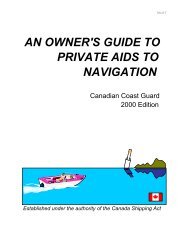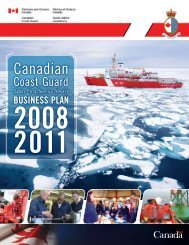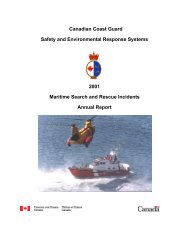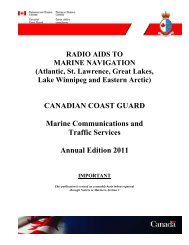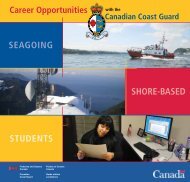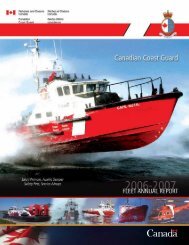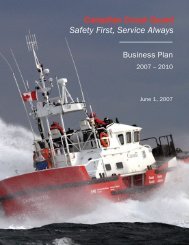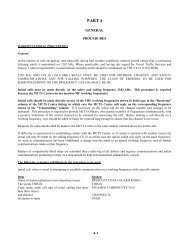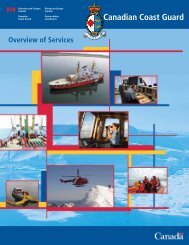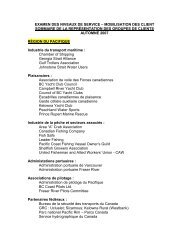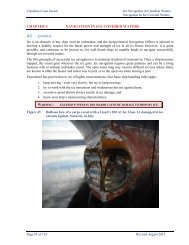Business Plan - Canadian Coast Guard
Business Plan - Canadian Coast Guard
Business Plan - Canadian Coast Guard
You also want an ePaper? Increase the reach of your titles
YUMPU automatically turns print PDFs into web optimized ePapers that Google loves.
34Section 4: What We Do Every DayThe MCTS program has first to ensure its continuity.Twenty-five percent of the MCTS workforce could leaveduring the next five years through retirement. CCGhas made the recruitment of new officers a priority, andmore than 70 new officers have been trained in the pastthree years. An average of 24 officers will be recruitedannually in the coming years. For this reason, RadioOperations (ROs) has been identified as an at-riskgroup in CCG’s Strategic Human Resources <strong>Plan</strong>.Marine Communications and Traffic ServicesProvides theseservices…• Responses todistress and safetycommunications**• Screening andissuance of Vessel/traffic clearances toships of 500 tons -gross tonnage or moreentering <strong>Canadian</strong>waters (Great Lakesnot included)**• Marine safetyinformation **To achieve thisresult…• Safety of life at sea,efficient movementof shipping, andprovision of essentialinformation tomarinersMeasuredthis way…*• MCTS CentresoperationsavailabilityNOTE: radio channelsare continuouslymonitored• Number ofclearances• Number ofNotships issuedMeasured thisway…*• Number of shipsother than pleasurecrafts involved ina marine accidentdue to a collisionWith thesetargets…• 24/7 availabilityfor MCTS Centresand operators;100 %• Benchmark =15,200• Benchmark =13,000With thesetargets…• Maintain a fiveyear annualaverage; 2001-2005 average = 17* These are the performance indicators in the CCG PerformanceMeasurement Framework.** In accordance with Levels of Service and Service Standards(www.ccg-gcc.gc.ca).Table 7: Marine Communications andTraffic Services Resource Profile, 2009-2010(thousands of dollars)Region Salary O&M TotalNewfoundland and Labrador 5,212.7 838.0 6,050.8Maritimes 5,431.8 607.6 6,039.4Quebec 6,095.2 405.3 6,500.5Central and Arctic* 4,406.0 1,741.6 6,147.6Pacific** 8,800.9 1,977.1 10,777.9National Capital Region 2,074.0 1,413.8 3,487.8National Programs*** 475.0 921.6 1,396.6Direct Program Total 32,495.7 7,904.9 40,400.6<strong>Coast</strong> <strong>Guard</strong> Fleet OperationalReadiness Allocation884.3 331.4 1,215.6Lifecycle Asset ManagementServices Allocation11,951.3 5,595.8 17,547.1Total Service Cost 45,331.3 13,832.1 59,163.3* Central and Arctic Region O&M resources are higher than those in theother regions because of the Northern housing allowance and travel costto the North.** Pacific Region salary dollars are higher because of the need to staff moreMCTSOs in response to the region’s marine traffic volume.*** National Programs consist of $1,343.3K in the Automatic IdentificationSystem project and $53.3K in research and development.Key InitiativesNAVAREASNAVAREAs are geographical sea areas established bythe International Maritime Organization to coordinatethe transmission of navigational warnings to mariners.In October 2007, the IMO confirmed Canada in itsrole as international coordinator and issuing service fornavigational warnings for two NAVAREAs in the Arctic.In 2008-2009, we worked with domestic andinternational partners to finalize the planning of theinternational service. During the upcoming planningyear, we are seeking funding approval to purchaseequipment and train personnel to begin the serviceon January 1, 2010, on a test basis.2009-2010CommitmentInitial testing of operating condition.2010-2011Implement the service through the advertisement andcommencement of NAVAREA transmissions.LeadDG, MSDG, ITSAC, C&ADG, MSDG, ITSAC, C&A<strong>Canadian</strong> <strong>Coast</strong> <strong>Guard</strong> — www.ccg-gcc.gc.ca



